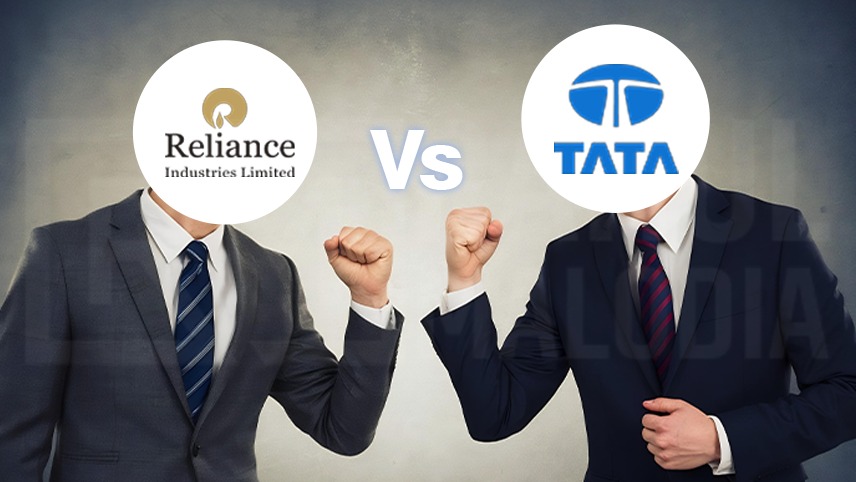
Tata vs Reliance: Brand Strategy Comparison for Modern Indian Entrepreneurs
The Two Giants That Shaped India’s Business DNA
Imagine you’re starting your own company in India today. You dream of building something big. You want to scale, go global maybe, or at least dominate your sector. But somewhere deep down, two names keep echoing in your mind Tata and Reliance.
Why?
Because in India, when we think of success, we think of these two titans.
Tata vs Reliance isn’t just a battle of empires, it's a masterclass in brand strategy, trust-building, and navigating the Indian consumer mindset. Both have done it. But how did they do it? That’s the story every Indian entrepreneur needs to know.
Same battlefield, different strategies
Tata and Reliance are names every Indian knows. They quietly impact your routine without you even knowing. Your morning salt might be from Tata. Your mobile data? That’s likely to be Jio. You book a Taj room, it’s Tata. You stream IPL, that’s Reliance. Yet, these brands feel very different.
Tata’s brand strategy whispers trust, ethics, heritage. It’s the brand your parents respected. The one that never felt aggressive.
Reliance’s brand strategy, on the other hand, roars ambition, scale, and disruption. It’s the rebel that doesn’t just play the game it rewrites the rules.
So, why do both work? And what can you, as a modern Indian entrepreneur, learn from them?
Trust vs Transformation The Core Identity Game
At the heart of Tata’s brand is trust. This isn’t accidental. From day one, Tata focused on nation-building. It created industries India never had. Steel. Power. Airlines. Hospitality. It built institutions. In the process, it formed a strong emotional bond with the country.
The message was simple: We don’t just make money, we care.
Reliance, under Dhirubhai Ambani and later Mukesh Ambani, took a different route. It bet big. It moved fast. It entered markets no one else dared. And it disrupted them hard.It moved from polyester to petroleum to telecom, always pushing forward.. It scaled fast, and it scaled aggressively.
Reliance’s branding isn’t about gentle persuasion. It’s about strong dominance. It’s not here to earn your trust slowly, it wins it by delivering value, scale, and power.
Both built empires. But they built them on two very different emotional foundations.
The Indian Consumer Mind: Who Understands It Better?
India is complicated. Diverse. Price-sensitive yet aspirational. Loyal yet fickle. You can’t crack this market with logic alone. You need emotional intelligence.
Tata tapped into values. Ethics. Pride. Stability. It never chased attention. Instead, it earned loyalty. This is why a Tata Nano, the cheapest car in the world, didn't succeed as expected. Tata’s emotional value came from what it represented: class, culture, and credibility.
The Nano came across as something you settled for, not something you dreamed of.
Reliance, meanwhile, taps into Indian emotions with perfect timing. Think of Jio. Free data. Free calls. It wasn’t just a product. It was a revolution. It felt like power in your hands. Unlimited data became common, and it transformed how India worked, learned, and lived.
Reliance’s branding strategy always speaks the language of scale and empowerment. It says: “We’ll give you more. Faster. Cheaper. Better.”
So while Tata earns trust slowly, Reliance creates impact instantly.
Tata's Marketing: More Meaning, Less Volume
Tata rarely shouts. Its ads are subtle. Clean. Sometimes even poetic. When Tata Salt says “Desh Ka Namak,” it’s not selling salt. It’s selling national pride. When Tata Tea says “Jaago Re,” it’s not about tea. It’s about awakening minds.
Tata speaks with the quiet confidence of someone you trust. A brand that stays quiet, because trust already does the talking.
Now contrast that with Reliance. From Jio’s aggressive launch to Reliance Retail’s massive expansion, everything feels like a blockbuster. Loud. Visible. Dominant.
Reliance’s marketing doesn’t whisper it thunders. Its tone is that of a visionary CEO in a boardroom shouting, “We’re going to change everything!”
And truth be told both tones work. For different reasons. For different audiences.
The Leadership Brand: Ratan Tata vs Mukesh Ambani
When you think of Ratan Tata, you think of grace. Humility. Vision. Integrity. He’s one of those rare business icons that feels universally respected. Not feared. Not envied. But genuinely admired.
His personal brand added massive emotional equity to the Tata brand strategy. Because in India, the face behind the brand matters. Especially when it’s someone who steps in to help the nation in a crisis or invests in startups to give back.
Mukesh Ambani, on the other hand, feels more distant. More powerful. More strategic. He rarely speaks in public. He lets his empire do the talking. But make no mistake his vision is razor sharp. He’s not building just a business. He’s building a network of dominance.
When Reliance launches, it doesn’t test the waters. It builds the ocean.
As an Indian entrepreneur, the question is: What kind of brand leader do you want to be? The respected face of your brand? Or the silent architect behind massive impact?
Risk Appetite: Who Plays It Safe?
Now it gets even more exciting.
Tata is calculated. Conservative even. It tests. It evaluates. It listens. It plays the long game. That’s why it has survived every storm since 1868. That’s why people still buy Tata products during market uncertainty.
Reliance thrives on risk. Its entire business model is built on bold bets. Jio’s free data model cost the company billions in early losses but it wiped out competition. And once it owned the market, it made back every rupee, and more.
This is a huge lesson in brand strategy. Some brands protect. Others attack. And both models work if you stay consistent with your vision.
House of Brands or Branded House: Which Strategy Works Best?
You may not notice this at first glance, but Tata uses a branded house strategy. Which means everything carries the Tata name. Tata Motors. Tata Steel. Tata Cliq. Tata Power. This builds trust quickly but it also means one mistake can hurt the whole family.
Reliance, meanwhile, uses a house of brands strategy. Its ventures often have independent names. Jio. AJIO. Reliance Trends. Viacom18. This gives flexibility. If one brand fails, the rest are untouched. But it requires extra investment in building brand recall.
This subtle difference tells you a lot about how each company thinks about scale, risk, and brand protection.
For you as a modern entrepreneur, the takeaway is simple: Decide early do you want your brand to be one strong name? Or a family of distinct identities?
Digital Strategy: Playing Catch-Up vs Leading the Race
Let’s be honest, Reliance is way ahead digitally.
From owning telecom infrastructure to OTT platforms, from AI to e-commerce, Reliance has created a digital empire. True impact comes from shaping change, not chasing it. And it’s doing this with speed.
Tata, in contrast, has been catching up. It’s making moves, Tata Neu is one example. But it still feels like it’s figuring out how to translate its old-school trust into new-age digital dominance.
With Instagram, data, and digital payments everywhere, Reliance fits right in with the new generation. More in tune with the pulse of today’s India.
But here’s the thing: trust still matters. Tata is bringing together its rich past and a forward-looking approach. It may move slower but when it does move, it moves with intent.
What Should Indian Entrepreneurs Learn From This?
The comparison isn’t about who’s better. It’s about what fits your mindset.
If you believe in building slow, ethical, emotionally-connected brands that stand the test of time, study Tata’s brand strategy.
If you believe in market capture, speed, disruption, and scale, Reliance's strategy will speak to your soul.
There’s no right or wrong. There’s only alignment. Some of you may be builders. Some may be disrupters. Both are powerful paths. But only when you own your path completely.
Why Tata vs Reliance Is More Than Just a Brand Face-Off
Today’s Indian market is changing faster than ever. New entrepreneurs are rising from Tier 2 and Tier 3 cities. Customers are smarter. Loyalty is fragile. Digital-first brands are everywhere.
In this chaos, building a brand that lasts is harder than ever.
But if there’s one lesson Tata vs Reliance teaches us, it’s this:
No matter what you build, how you make people feel will always be more powerful than what you sell.
Whether you lead with emotion or domination, ethics or disruption your brand strategy will decide if you just survive or truly thrive.
So the next time you pick a strategy for your business ask yourself?
Are you building a Tata?
Or are you building a Reliance?
Either way, choose with clarity. Build with courage.
Frequently Asked Questions (FAQs)
1. What are the key differences between Tata and Reliance’s brand strategies?
Tata focuses on building trust, ethics, and emotional connection through slow and steady growth, while Reliance prioritizes speed, scale, and disruption. Tata uses a conservative approach with a focus on long-term value, while Reliance plays aggressively and innovatively, often leading the market with bold moves like Jio.
2. Which brand strategy should Indian entrepreneurs adopt Tata’s or Reliance’s?
It depends on your business goals. If you aim for slow and steady growth with a deep connection to your customers, Tata’s strategy of trust-building could be your path. However, if you prefer rapid market capture, innovation, and digital dominance, adopting Reliance’s approach may suit you better. Both strategies work, but they align with different business philosophies.
3. How does the leadership of Tata and Reliance impact their brand strategies?
Ratan Tata’s humble and respected leadership adds immense credibility and trust to Tata’s brand. His personal integrity has been integral to Tata’s identity. On the other hand, Mukesh Ambani brings boldness, vision, and innovation to Reliance. His strategic risk-taking, particularly with projects like Jio, has helped Reliance dominate its sectors.
4. What lessons can modern Indian entrepreneurs learn from Tata and Reliance?
Modern entrepreneurs can learn the importance of aligning their brand strategy with their leadership style. Tata teaches the value of trust, long-term commitment, and responsibility towards society, while Reliance teaches the power of scale, speed, and market disruption. The key is to understand your target market and align your approach accordingly.
5. How did Reliance’s Jio disrupt the Indian telecom market?
Jio disrupted the Indian telecom market by offering free data, calls, and SMS initially, effectively making mobile data affordable for millions of Indians. This aggressive pricing strategy forced competitors to follow suit, transforming the Indian telecom industry and giving Reliance a massive consumer base.
6. Why is Tata’s brand voice considered more subtle compared to Reliance’s?
Tata’s brand voice is calm, humble, and ethical. Its marketing is understated, focusing on creating emotional connections with its consumers through trust and quality. Reliance, in contrast, has a louder, more ambitious brand voice, reflecting its bold business strategy and disruptive market moves.
7. What does the ‘House of Brands’ and ‘Branded House’ strategy mean for Tata and Reliance?
Tata follows a branded house strategy, where all its subsidiaries (like Tata Motors, Tata Steel, Tata Tea) carry the Tata name, ensuring consistency and brand trust across products. Reliance, however, uses a house of brands strategy, where individual brands like Jio, AJIO, and Reliance Trends maintain their own identities, giving flexibility and protecting other ventures in case one fails.
- Entrepreneurship
- Businessman
- Business Case study






